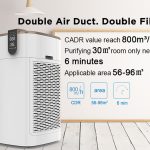The smog is still terrible, smoking indoors causes PM2.5 to directly explode

The haze and the low temperature, some smokers will stay at home to smoke. If you don’t open the windows and doors, the smoke will haunt the house in a while. The reporter found that if the number of cigarettes is ignited at the same time, the indoor PM2.5 will directly burst into a thousand! …is terrible, don’t smoke in the house for everyone’s health!
Experiment
Experiment in a room of approximately 20 square meters and close the doors and windows during the experiment. Test air quality in different states.
Experiment equipment
Experimental equipment: two packs of cigarettes, lighters, laser detectors, laser detectors can detect PM2.5 concentration and formaldehyde concentration in the air.
Experiment procedure
When the cigarette is not lit, the indoor condition is PM2.5 at around 230.
Experiment analysis
Note: Since the meter is more sensitive, the value fluctuates within a certain range, and the numerical interval represents the lowest value and the highest value in this state. According to the air pollution index level, the PM2.5 value is mildly polluted at 101-150, the 151-200 is moderately polluted, the 201-250 is heavily polluted, and the above 250 is severely polluted. According to the indoor formaldehyde content classification, when the indoor content is 0-0.05, it belongs to the safety level, 0.06-0.08 belongs to the general level, and 0.08 or more belongs to the excessive standard.
Experimental result
In terms of PM2.5 concentration, the experiment found that when the cigarette was ignited, the concentration began to rise. When igniting a cigarette (such as smoking in a room), the local concentration of PM2.5 exceeds 250 μg/m3, that is, the local air quality reaches a serious level of pollution. When igniting 10 cigarettes (such as many people smoking at indoor gatherings), the PM2.5 concentration is stable at around 700 μg/m3, and the instantaneous PM2.5 can reach 1000 μg/m3, which is the highest value of the sputum.
In addition, the door and window ventilation was not opened during the experiment, which means that if the indoor smoking continuously, the PM2.5 concentration will be in a cumulative state. At the same time, after the cigarettes are burned out and the smoke is ‘invisible’, the value will drop rapidly. For example, after 20 cigarettes are burned out, the value no longer lasts between 900 and 1000 mg/m3, but falls to the range of 700-800 mg/m3.
The formaldehyde concentration data shows that the formaldehyde data will increase after the cigarette is ignited. When the PM2.5 concentration was increased to about 600 μg/m3, the formaldehyde content increased to 0.18 mg/m3. When PM2.5 to 1000 μg/m3, the instantaneous formaldehyde concentration can reach 1 mg/m3. In other words, smoking indoors will increase the concentration of formaldehyde.
Expert: Smoking in the haze days is a ‘health’ for health hazards
Yang Yue, director of the Department of Thoracic Surgery, Peking University Cancer Hospital, said that smoking and smog have a commonality to the human body. They are all breathing system without oxygen exchange; therefore, smoking indoors in smog can be said to be ‘additional.’
Experts said that people in the haze are used to closing the doors and windows. If you smoke indoors, the air will not circulate and the concentration will be very high. It can be seen that the haze day itself makes the oxygen content lower. At this time, the smoking increases the anoxic state of the cardiovascular and cerebrovascular system, forming a heavy diaphragm.
Olansi Healthcare Industry portable air purifier is willing to work with more families to further study and manage family indoor issues and contribute to more family health.If you are interested in this, please contact us for more products and preferential prices
Helen:
+86 13922346046
info@olansiglobal.com
https://www.olansiglobal.com


